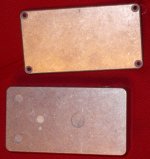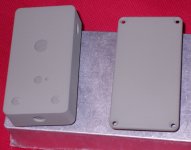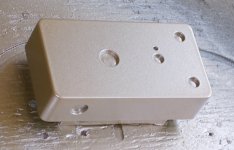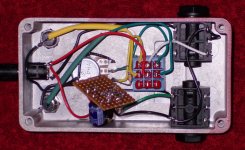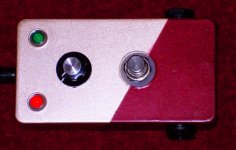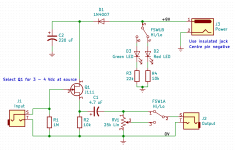I recently decided to tackle a small (but still useful) electronics project. A bit of background:
There is no on-off switch, since I decided this would be an always-on pedal.
Since the signal is never boosted - gain is either unity, or less than unity - this isn't a booster pedal, it's an unbooster pedal. 🙂
The pics tell the rest of the story.
-Gnobuddy
- I have a couple of guitars with pickups that are sufficiently powerful that, when strummed, they distort one of my guitar FX pedals (a Joyo compressor), and even overload the input of my Fender Princeton Reverb (reissue.)
- A couple of my humbucker-equipped guitars suffer from serious tone-suck (treble loss) if you turn down the volume on the guitar itself, because the increased source impedance of the guitar interacts with the guitar cable capacitance. One of these guitars is a semi-hollow type, so it's hard to access the pots to install "bright caps" on the guitar.
- Like every guitarist who frequently plays both rhythm and lead in the same song, I often wish there was a quick and fool-proof way to drop the guitar level down by just the right amount for chord strumming, and bring it back up by just the right amount for single-note solos.
There is no on-off switch, since I decided this would be an always-on pedal.
Since the signal is never boosted - gain is either unity, or less than unity - this isn't a booster pedal, it's an unbooster pedal. 🙂
The pics tell the rest of the story.
-Gnobuddy
Attachments
Very good and useful.
Problem is that pedals standardized on 9V supplies, which was adequate "way back then" , with weaker pickups, but nowadays powerful ones already reach that limit when strummed hard, even with no amplification, so ......
Problem is that pedals standardized on 9V supplies, which was adequate "way back then" , with weaker pickups, but nowadays powerful ones already reach that limit when strummed hard, even with no amplification, so ......
I like jfet circuits, and source followers make great buffers. Whats your favourite jfet for this? and what source resistor are you using? I was using 2n5457, with 22k, biased at the gate to get a source voltage just above half the supply, like 5v.
I wanted the circuit to be as simple as possible to fit in the rather small Hammond enclosure I had, so the plan was to use self-bias, with the gate tied directly to ground. With a nominally 9V power supply, it looked like a JFET with a pinch-off voltage around 4 - 5 volts would be ideal.I was using 2n5457, with 22k, biased at the gate to get a source voltage just above half the supply, like 5v.
I didn't have any JFETs with a datasheet Vp that high, so I decided to settle for anything that would bias up to more than the usual 1.5 volt Vgk of the typical half-12AX7 triode input stage.
I ended up with a bit of an odd choice, a J113. I found a couple that biased up to around Vgs = -1.8V (with a 10k source resistor, and the gate tied to ground via 1 megohm.)
So that's what ended up in the Unbooster. 1M gate resistor, 10k source resistor, 50k log volume pot with a 10k taper resistor wired to make the log pot behave more like a linear pot. I should have just used a 10k - 25k linear pot, but didn't have one in the junk-box!
Will 1.8V bias be enough? Testing at home at low SPL, so far I haven't managed to make the Unbooster distort with any of my guitars. I'll find out tonight enough if I hear any distortion at music-jam SPL levels. 🙂
An hour after I finished building the Unbooster, I found a small bag containing a few J111 JFETs. They have a higher Vp than the J113. Drat!
-Gnobuddy
Last edited:
I reckon 1.8V is about ok, unless you have very hot pickups or crazy series wiring, and thrash the strings hard. But one more resistor and cap and you could bias it more optimally. Mind you, Ive measured 3V from one of my guitars doing that! My 2N5457 will usually make a good common-source booster for a few db of clean gain, and is that case, Vgs is also about 1.8V with gate biased to ground. I have some MPF102 with 3 or 4V Vgs, and inside a guitar, the gate can be just directly connected to the volume pot, so the whole buffer circuit is just jfet, source resistor and output cap.
Add a 220uF filter cap across the power supply rails and a 1N4007 diode for reverse-polarity protection, and that's what's on the tiny little circuit board in the Unbooster. 🙂...so the whole buffer circuit is just jfet, source resistor and output cap.
-Gnobuddy
This unbooster is equivalent to the buffers I insert into my electric guitar collection (all in all 2 pieces).
The JFET maybe a low-pinch-off type like 2SK170 as well, provided you apply some pos gate voltage from a voltage divider.
With a source resistor of 10kOhm and a source drop of 2~3V equivalent to 0.2~0.3mA current drain a normal 9V Block lasts ages.
max peak voltage depend on your playing technique as well, you have to measure with an oscilloscope.
The JFET maybe a low-pinch-off type like 2SK170 as well, provided you apply some pos gate voltage from a voltage divider.
With a source resistor of 10kOhm and a source drop of 2~3V equivalent to 0.2~0.3mA current drain a normal 9V Block lasts ages.
max peak voltage depend on your playing technique as well, you have to measure with an oscilloscope.
...but combined with a rhythm/solo footswitch, which is the main reason I built the unbooster. I use a fairly short guitar cable (15 ft or about 5 metres), and don't feel the need for a buffer with any of my guitars when the guitar volume control is set to full - only when the guitar volume is lowered.This unbooster is equivalent to the buffers I insert into my electric guitar collection
The unbooster lets me drop the volume by a preselected exact amount, and without any accompanying treble loss. From the electronics point of view it's absurdly simple, but as a guitarist, I find it comes in quite handy.
Agreed, and I find the song itself matters as well. My wife and I both like many Crowded House songs, and one that she likes to sing is "Pineapple Head" ( YouTube ).max peak voltage depend on your playing technique as well
That lovely rhythm guitar part needs to be played with some energy to capture the feel of the song. When my wife sings this song and I accompany her on my Ibanez AS-73 semi-hollow guitar ( https://www.sweetwater.com/store/detail/AS73TCD--ibanez-artcore-as73-transparent-cherry-red ) or Agile AS-800 (similar to Agile AS-820 Prestige Semi-Hollow at Home ), this song is sure to clip my Joyo compressor hard enough to sound like a fuzz-box. 🙂
On the other hand, if I'm accompanying my wife when she sings the sorrowful traditional Celtic song "If I Were A Blackbird" ( here is a harp version: YouTube ), there is no chance of anything clipping, and no Unbooster is needed at all. 🙂
The AS-73 was the first affordable semi-hollow guitar I know of, and I bought mine in the 1990s, before today's enormous selection of affordable Chinese-made guitars became available to everyone with a credit-card. While the AS-73 looks a lot like a Gibson ES-335, Ibanez chose to install surprisingly high-output pickups in it. So the AS-73 looks like a jazz guitar at first glance, but plays as though it was designed for rock.
I play my Agile AS-800 a lot more than the Ibanez these days, mainly because it has a wider fretboard which is a much better fit for my big fingers. The Agile also has a better neck, and a much better factory fret job.
-Gnobuddy
Here's the schematic, just in case anybody cares.
The diode in the positive line is to protect against accidental reverse polarity, which is particularly likely since guitar FX pedals operate on an old (and now quite bizarre) standard, with the centre pin of the power supply negative, and the outer barrel positive.
-Gnobuddy
The diode in the positive line is to protect against accidental reverse polarity, which is particularly likely since guitar FX pedals operate on an old (and now quite bizarre) standard, with the centre pin of the power supply negative, and the outer barrel positive.
-Gnobuddy
Attachments
looks great!
Do you get any clicks coming through the signal from the LED switching? I sometimes put a couple of hundred ohms in the + supply line, after the LEDs, to help the smoothing cap keep control.
Do you get any clicks coming through the signal from the LED switching? I sometimes put a couple of hundred ohms in the + supply line, after the LEDs, to help the smoothing cap keep control.
Thanks!Do you get any clicks coming through the signal from the LED switching? I sometimes put a couple of hundred ohms in the + supply line, after the LEDs, to help the smoothing cap keep control.
I did leave room for the resistor, but thought I'd try without and see what happened. I haven't heard any clicks yet, but haven't had the amp turned up to stage volume yet.
I'm using fairly high-efficiency LEDs, and the currents through them are quite low (maybe 700 uA for the red, half that for the green LED, ). The low current probably helps reduce clicks too. 🙂
-Gnobuddy
Yes, and the diode may help stop the cap from trying to supply back to the LEDs if there's a transient while changing.
Very cool, great execution. You should jazz up the enclosure with some snazzy artwork and market it to the bo-teek pedal crowd. Easy $150 a pop.
Did you ever measure the peak output of your guitar that OL your Fender Princeton? I'm curious what it's pumping out. I use EMG's and unless I beat the crap out of the strings, there isn't any appreciable clipping at V1a on my amp.
Did you ever measure the peak output of your guitar that OL your Fender Princeton? I'm curious what it's pumping out. I use EMG's and unless I beat the crap out of the strings, there isn't any appreciable clipping at V1a on my amp.
Thanks! 🙂Very cool, great execution.
Did you hear about the "bo-teek" pedal brand "Freekish Blues" back around 2013 or so? Some guy with an atrophied conscience was repainting budget-priced Joyo pedals in his garage, and selling them for three or four times the price: Freekish Blues Pedals Are Really Repainted Joyos! | CheaperPedals.com...market it to the bo-teek pedal crowd...
I haven't done that yet, I really should. My old Ibanez AS-73 seems to be the one with the highest output, and my Agile AS-820 is the next highest. The Ibanez will overload the Fender input if you just strum six-string chords, and not hard, either - I don't play with a heavy hand!Did you ever measure the peak output of your guitar that OL your Fender Princeton? I'm curious what it's pumping out.
Have you tried with a clean-as-clean-can-be tone? That will make it easier to hear any brief clipping on the initial attack transient when the string first slips free of your guitar pick.I use EMG's and unless I beat the crap out of the strings, there isn't any appreciable clipping at V1a on my amp.
One member on this forum said he could get 10-volt spikes straight out of his guitar (with conventional magnetic passive pickups.) I was cautiously skeptical - until he posted oscilloscope captures. Yikes!
-Gnobuddy
Wow, some people will do anything to make a buck.Did you hear about the "bo-teek" pedal brand "Freekish Blues" back around 2013 or so?
That reminds me, I'd read (I think on grailtone forums) that the very early Mesa Dual Rectifiers had Soldano SLO boards in them. I don't think it was ever substantiated though. Cloning/stealing designs is nothing new, but at least make your own "innards"!
To be fair he did alter some circuit values to modify/improve the operation in addition to the repaint.Did you hear about the "bo-teek" pedal brand "Freekish Blues" back around 2013 or so? Some guy with an atrophied conscience was repainting budget-priced Joyo pedals in his garage, and selling them for three or four times the price: Freekish Blues Pedals Are Really Repainted Joyos! | CheaperPedals.com
Considering the initial cost of the item, plus the cost of the rework (plus warranty etc) the markup is not exorbitant.
Some are too fast to condemn, people gotta eat.
Dan.
What I condemn is the deception. If this guy made it clear to his customers that he was tweaking $40 Joyo pedals to improve the sound, and you could buy his tweaked Joyo pedals for $150, I would have no problem with that whatsoever.Some are too fast to condemn, people gotta eat.
Dan.
-Gnobuddy
- Status
- Not open for further replies.
- Home
- Live Sound
- Instruments and Amps
- An Unboost pedal for electric guitar
